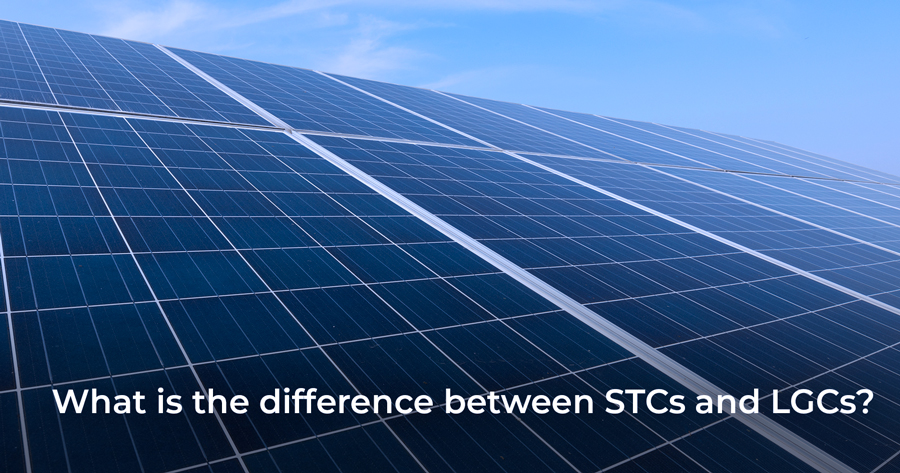What is the difference between STCs and LGCs?

Updated as of October 2020
The Renewable Energy Target is a Federal Government policy made up of two legislated schemes that, though initially designed to end in 2020, continue to operate until 2030 under the Renewable Energy (Electricity) Act 2000.
Split into two parts, the Renewable Energy Target encompasses the Large-scale Renewable Energy Target (LRET) and the Small-scale Renewable Energy Scheme (SRES). The LRET creates LGCs, while the SRES creates STCs, financial government incentives designed to encourage home and business owners to invest in renewable energy.
Essentially performing the same function, STCs are eligible for small scale renewable energy generation installations under 100kW, while LGCs are eligible for large scale renewable energy installations above 100kW.
STCs and LGCs also differ in how they are generated and sold, which this blog will explore.
Small-scale Renewable Energy Scheme
The Small-scale Renewable Energy Scheme (SRES) aims to create a financial incentive for individuals and small businesses to install eligible small-scale renewable energy systems such as solar panel systems, small-scale wind systems, small-scale hydro systems, solar water heaters, and air source heat pumps. Small-scale technology certificates are provided upfront for the system’s expected power generation from the year of installation until 2030, when the scheme ends, essentially giving eligible participants an upfront discount for their investment.
How STCs are Generated
As previously mentioned, the role of the SRES is to issue Small-Scale Technology Certificates (STCs) for renewable energy installations under 100kW in size.
The number of STCs issued is based on how much electricity the system will generate until 2031, with one STC equalling one megawatt-hour of electricity.
STCs are a type of electronic currency that can be purchased, sold, and traded on an open market, meaning their value fluctuates with supply and demand. The value typically fluctuates between $34 and $40, and the average value of an STC as of 2020 is $37. It’s common practice to allocate the STCs to the system provider in exchange for a discount on the upfront purchase price.
Commercial Example
A 100kW system will produce around 1,520MWh worth of electricity until 2030, meaning your business would currently receive 1,520 STCs. So if the value of an STC is $37, you’d receive a $56,240 discount off the cost of a 100kW system.
Residential Example
A 5kW system will produce around 76MWh worth of electricity until 2031, meaning you are entitled to 76 STCs. So if the value of an STC is $37, you’d receive a $2,812 discount off the cost of a 5kW system.
STC Phase-Out
Due to Federal Government changes, STC’s will reduce by 1/15 (around 6-7%) every year. They will continue to decrease until 2030 when phased out completely. Therefore, the sooner you invest in a solar power system, the more you’ll save on the upfront cost.
Unfortunately, there is also no guarantee the Small-scale Renewable Energy Scheme will stay in place until 2031, as the Federal Government, regardless of which party holds power, has the ability to axe the incentives at any time.
The Large-scale Renewable Energy Target scheme
The Large-scale Renewable Energy Target scheme was initially designed to encourage investment in large-scale renewable power stations to help Australia achieve 33,000-gigawatt hours of additional renewable electricity generation by 2020. Since this date has been reached, the date has been extended to 2030. However, the target stays the same from 2020 to 2030, and, under the current law, new renewable energy power stations can continue to be accredited after 2020. In addition, any solar power system that can generate more than 100kW is subject to the Large-scale Renewable Energy Target scheme.
How LGCs are Generated
One Large-Scale Generation Certificate (LGC) is created for every megawatt-hour of electricity your system generates. Like STCs, LGCs can be purchased, sold, and traded on an open market. So, the value fluctuates according to supply and demand. As of 2020, the average price of an LGC was $48.
The key difference between STCs and LGCs is that LGCs are produced on an ongoing basis instead of STCs created upfront. Hence, your business receives a yearly “rebate” instead of an upfront discount on the system’s total cost.
For example, a 200kW system would produce an average annual solar output of 320,000kWh or 320MWh. Therefore, it would create 320 LGCS per year. Using the average 2020 price of LGCs as a guide, a 200kW system would receive around $15,360 per year in government incentives.
Accreditation and Creating LGCs
To create LGCs, your solar PV system needs to become an ‘accredited power station’ and, your business must first apply for accreditation as set out by the Renewable Energy (Electricity) Act 2000 (REE Act) and the Renewable Energy (Electricity) Regulations 2001. The first step in doing so involves you becoming a ‘registered person’ in the REC Registry.
Following successful accreditation, LGCs can be created in the government REC registry, where, once validated, they can be made available for purchase. As previously mentioned, just like STCs, LGCs are sold through the open market, where the price will vary according to demand.
While this is the traditional method of creating and selling LGCs, Infinite Energy offers two additional options which remove the price risk associated with the long-term LGC market price.
LGC Rebates Upfront
Instead of creating your LGCs on a year-by-year basis, Infinite Energy will pay your expected LGC revenue upfront. Infinite Energy will then take on the administration of creating and selling the LGCs.
Receiving the LGC revenue upfront means your upfront capital cost is significantly reduced, making it perfect for projects restricted by a specific budget.
Under this option, Infinite Energy takes on the risk associated with the long-term LGC market price and provides your business with a fixed upfront discount. Because of this risk, the LGC value offered by Infinite Energy will not be as high as the current market price.
Hedging LGCs
Infinite Energy can also offer LGCs in the traditional annual model but hedge and guarantee the spot price for the first 5 to 10 years.
This option provides your business with price certainty and removes any risk associated with fluctuations in the long-term market price for LGCs, making it well suited for those who are risk-averse.
As with receiving LGCs upfront, Infinite Energy takes on the LGC price risk, so the value offered when hedging LGCs is likely to be less than the current spot price.
With over 18,000 solar installations under our belt, Infinite Energy can assist and manage the accreditation and sales process for both STCs and LGCs.
If you would like more information on government incentives for solar, please call us on 1300 074 669, or contact us today.


